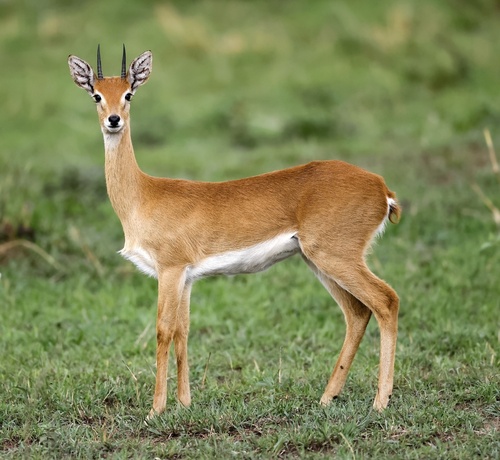
Oribi
The Oribi, Ourebia ourebi, gracefully roams Africa's savannas with its slender build and striking facial markings. Adapted to open grasslands, this alert antelope is a master of evasion, vital to its survival amidst predators. Its role in the ecosystem supports grassland health through selective grazing.
8-12 years
Lifespan
13.6 - 14.1 kg
Weight
Height: 51 - 66 cm
Size
Yellow, Red, White, Orange
Color
7-14 months
Age of Sexual Maturity
3 months
Age of Weaning
Low
Aggression
Least Concern
Conservation Status
Decreasing
Population Trend
Characteristics
Ourebia ourebi, commonly known as the Oribi, is a small antelope found in sub-Saharan Africa. It inhabits grasslands and open savannas, where it is well-adapted to grazing. The Oribi is characterized by its slender body, long neck and legs, and distinctive black markings on its face and tail. It is known for its keen senses and ability to make swift escapes from predators.
Distribution Range of the Oribi
Ourebia ourebi, commonly known as the Oribi, is native to sub-Saharan Africa. Its geographical distribution includes countries such as Senegal, Ethiopia, South Africa, and Kenya. The Oribi is primarily found in eastern and southern Africa, with populations scattered across grasslands and savannas.
Oribi's Habitat
Environmental Conditions
Oribis inhabit open grasslands, floodplains, and savannas, preferring areas with short grasses where they can easily spot predators. These regions typically have a tropical or subtropical climate with distinct wet and dry seasons. The Oribi is well-adapted to environments with moderate to low rainfall and is often found in areas with a mix of open grasslands and light scrub or bush.
Ecological Niche
The Oribi is a small antelope that occupies a niche as a grazer, feeding primarily on grasses and occasionally on forbs. Its habitat selection is influenced by the availability of grasses, which constitute the bulk of its diet. The Oribi is also an important prey species for large carnivores, contributing to the ecological balance within its habitat.
Copyright @ Nature Style Limited. All Rights Reserved.
 English
English